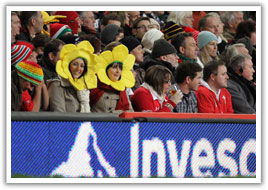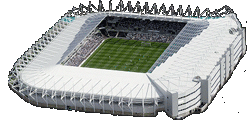Rheoli Diogelwch
Mae’r cyfrifoldebau rheoli manwl yn perthyn i’r categorïau sylfaenol canlynol, a dylai’r rheolwyr ymdrin â phob un o’r rhain wrth sefydlu strwythur rheoli diogelwch:
a. Legislation:
Management should be aware of:
- the requirements of the safety certificate (if applicable)
- safety of sports grounds legislation
- fire safety legislation
- health and safety at work legislation
- legislation relating to people with disabilities
- civil contingencies legislation
- any other specific pieces of legislation that may have relevant safety implications
b. Staffing
Management should:
- identify those to whom it intends to allocate safety duties
- draw up and keep under review job descriptions for all posts holding safety duties and resource such posts
- appoint an occupationally competent safety officer and deputy
- ensure all operational safety-related posts are held by appropriately trained and competent persons
c. Planning
Management should:
- draw up a written safety policy for spectators
- draw up an operations manual
- draw up contingency plans
- agree an emergency procedure plan
- agree procedures for accommodating all spectators, including those with disabilities, the elderly, families and children and, where appropriate, supporters of visiting clubs
d. Monitoring and records
Management should:
- using standard forms, record all incidents and circumstances which have the potential to cause accidents, prioritise and monitor subsequent remedial actions and maintain an audit trail
- conduct periodic safety audits and reviews, in particular after any major event, and draw up any consequent action list
- ensure that no other management decisions or policies compromise safety at the sports ground
- maintain records of each event in respect of the event itself, stewarding, the fabric of the ground and first aid and medical provision
e. Risk assessment
Management must carry out site-specific risk assessments for all events including any ancillary activities. Risk assessment should not impose a burden but should encourage the formulation of practical and systematic action plans to reduce the level of risk to spectators.
It is recommended that the assessments should be undertaken by competent persons with the appropriate skills and experience. Specialist advice may need to be sought, but members of the management’s safety team should contribute their own experience and knowledge of the ground being assessed, including its operation during events.
Risk assessment should consist of the following steps, all of which should be documented:
- identify hazards to which spectators may be exposed
- determine which spectators may be harmed and how
- evaluate the risks and decide on the precautions to be taken
- record the findings and implement preventative and/or protective measures
- assess and review the adequacy and effectiveness of such measures and revise them where necessary
Experience has shown that hazardous situations may develop immediately before and during events. These may not have been identified in the pre-event risk assessments.
It is therefore recommended that management should implement a system of ongoing risk assessment during the event. This will assist and inform its safety decisions as the event proceeds. Such risk assessments should be documented.
It is recommended that when conducting risk assessments management should consult with the relevant authorities. Further guidance is available from the Health and Safety Executive.
Gweithgaredd 1
Lluniwch gyflwyniad o 10 sleid, yn crynhoi cyfrifoldebau rheolwyr stadiwm chwaraeon.
Polisïau diogelwch gwylwyr
Mae’n un o ofynion deddfwriaeth gyfredol bod gan reolwyr pob maes bolisi diogelwch gwylwyr ysgrifenedig. Mae polisi o’r fath yn dangos bod y rheolwyr wedi rhoi meddwl ac ymdrech i ystyried diogelwch a lles y gwylwyr. Mae’n dangos hefyd bod y polisi wedi cael ei ddyfeisio’n ofalus yn ymarferol. Dylai’r polisi diogelwch:
- egluro amcanion diogelwch y rheolwyr a’r modd i’w cyflawni
- gael ei gytuno gan y rheolwyr a’i ledaenu a’i egluro i holl aelodau’r staff, staff contract, gweithwyr rhan-amser a gweithwyr gwirfoddol
- ddangos bod agwedd gadarnhaol tuag at ddiogelwch y cyhoedd o lefel uchaf y rheolwyr i lawr
- gael ei adolygu gan reolwyr yn flynyddol a’i ddiwygio yn ôl yr angen.

Dylai dogfen bolisi diogelwch gwylwyr nodi’n glir:
- athroniaeth rheolwyr y maes ynghylch diogelwch
- pwy sydd â’r cyfrifoldeb terfynol am ddiogelwch yn y maes
- i bwy mae cyfrifoldeb yn cael ei ddirprwyo
- y gadwyn awdurdod
- sut mae’r polisi diogelwch i gael ei weithredu a’i gyfleu
- sut mae’r polisi diogelwch i gael ei archwilio, drwy fodd mewnol ac allanol, a’i adolygu.
Dylai’r ddogfen bolisi ac unrhyw ddiwygiadau dilynol gael eu llofnodi a’u dyddio ar ran rheolwyr y maes gan y person a nodwyd fel yr un sydd â cyfrifoldeb terfynol.
Gweithgaredd 2
Crynhowch bwrpas a chynnwys polisi diogelwch gwylwyr.
Cynlluniau wrth gefn
Mae angen i reolwyr lunio cynlluniau wrth gefn er mwyn cydymffurfio â rheoliadau meysydd cyfredol. Mae’r wybodaeth isod yn crynhoi’r angen am gynlluniau wrth gefn a’u pwrpas.
Ground management should assess the risk of any incident occurring at the sports ground which might prejudice public safety or disrupt normal operations. Such incidents often arise with little or no warning and may not be capable of being dealt with by the management operating under normal conditions. Management should therefore prepare contingency plans to determine specific actions and/or the mobilisation of specialist resources. The contingency plans should be reviewed annually and after any incident, significant near miss or exercise. Following the review the contingency plans should be presented to the board of directors (or equivalent body) for ratification.
Contingency plans should lay down a structured and graduated response with clear guidelines on the measures to be adopted in particular circumstances, bearing in mind both internal and external factors specific to the individual sports ground.
Exercises to test contingency plans must be staged at least once a year in consultation with the relevant authorities and emergency services. It is essential that the safety officer, deputy and appropriate stewards have a full working knowledge of all the contingency plans. The procedures set out within contingency plans should also be made familiar to all staff at the sports ground, not only to those with specific safety-related duties.
Gweithgaredd 3
Mae rhestr o’r penawdau y dylid ymdrin â nhw mewn cynllun wrth gefn wedi’i rhoi isod. Ychwanegwch y geiriau coll.
- Fire
- Bomb threat, suspect package, terrorist attack (including chemical, biological, radiological or nuclear)
- Buildings and services
- damage to structures
- power cut or failure
- passenger lift or escalator failure
- gas leak or chemical incident
- Safety equipment failure
- turnstile counting mechanism
- closed circuit television
- public address system
- electronic information boards
- stewards’ radio system
- internal telephone systems
- fire warning systems
- Crowd control
- surging or crushing
- pitch incursion
- late arrivals or delayed start
- lock outs including progressive turnstile closure
- disorder inside the ground
- large-scale ticket forgery
- Emergency evacuation
- Severe adverse weather
- Ticketing strategy in the event of an abandoned fixture

Cliciwch y botwm dangos uchod i wirio eich atebion.
Cadw cofnodion
Mae’r rheolwyr yn gyfrifol am gadw cofnodion o bob digwyddiad, gan gynnwys:

- manylion am yr holl arolygiadau cyn y gweithgaredd
- manylion am y rhagbaratoi cyn y gweithgaredd a, lle bo’n briodol, unrhyw hyfforddiant a roddwyd i stiwardiaid
- nifer y gwylwyr a adawyd i mewn i’r maes a, lle bo’n briodol, i bob ardal o’r maes
- niferoedd a safleoedd pob person cymorth cyntaf a meddyg oedd yno
- ffurflenni digwyddiad yn cofnodi unrhyw ddamwain neu ddigwyddiad a allai fod wedi arwain at ddamwain
- manylion am bob triniaeth gymorth cyntaf neu driniaeth feddygol a roddwyd, tra’n cadw cyfrinachedd meddygol ynghylch pwy oedd y sawl a gafodd y driniaeth
- manylion am ddriliau argyfwng neu ymarferion gwagio ynghyd ag unrhyw ddigwyddiad a brofodd y cynlluniau wrth gefn
- manylion am unrhyw agor anarferol o allanfa
- manylion am unrhyw adeg pan gymerodd yr heddlu reolaeth
- manylion am unrhyw ddiffygion ynghylch diogelwch y maes a gododd o’r gweithgaredd, ynghyd ag unrhyw gamau a gymerwyd i unioni hyn
- adroddiadau am unrhyw symudiad arwyddocaol o’r adeiladwaith
- manylion am bob tân a phob tro y cychwynnwyd larwm tân
- manylion am bob methiant o systemau argyfwng
Mae’r rhestr uchod ar gyfer arweiniad yn unig ac ni fwriedir iddi fod yn gynhwysfawr ym mhob sefyllfa.
Gweithgaredd 4
Crynhowch yr amrywiaeth o gofnodion mae’n rhaid i reolwyr stadiwm chwaraeon eu cadw ac aseswch yr angen am y cofnodion hyn.
Chwaraewyr a chefnogwyr y gwrthwynebwyr
Nodir isod cyngor ynghylch cadw cefnogwyr y gwrthwynebwyr ar wahân a darparu ar eu cyfer.
At sports grounds where supporters of visiting clubs or teams attend, advance planning between the ground management, the visiting club or team and the police is essential to ensure that such supporters are:
- directed and welcomed to the ground
- directed to the appropriate entrances
- accommodated safely
- always kept clearly informed of any special arrangements made for them inside the ground and on their departure
Liaison between the management and police may be necessary to ensure that the likely numbers of visiting supporters is known. In consultation with the police, management should also determine clear policies on the accommodation of home and visiting groups of supporters and on appropriate ticketing arrangements. There should be debriefing meetings to evaluate these arrangements and, if necessary, formulate changes for future events.
When a large number of spectators are expected from a non-English speaking country, management should provide verbal or written information in the language of the visiting supporters.
If ground management adopts a policy of segregating groups of supporters, the arrangements for admitting spectators should be drawn up in consultation with the local authority and police, and be carefully controlled to ensure as far as possible that segregation is effective. Each segregated area must have its own independent means of egress or evacuation.
Where considered necessary, a neutral or sterile zone may be provided between groups of supporters. However, in all cases it is recommended that the method of segregation used should be flexible.
Management should ensure that each segregated area offers full access to sufficient toilet and catering facilities. It should not be necessary for spectators in segregated areas to have to cross barriers or seek special permission to use such facilities.
Management should also ensure that, wherever possible, sufficient viewing accommodation and facilities are provided in each segregated area for disabled spectators.
Gweithgaredd 5
Crynhowch y ddarpariaeth ar gyfer cefnogwyr oddi cartref mewn lleoliadau fel Stadiwm Liberty.
